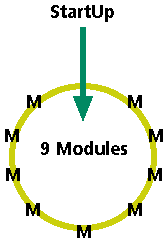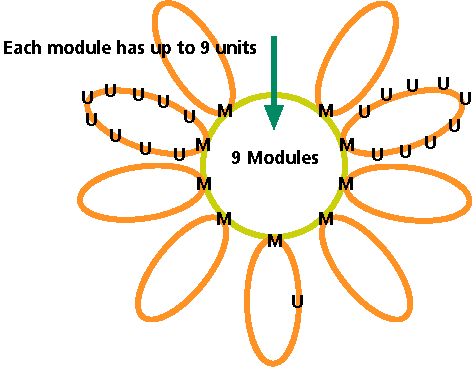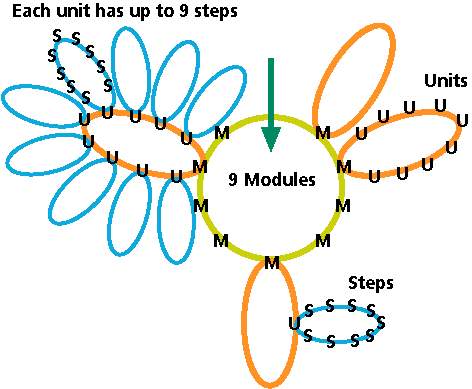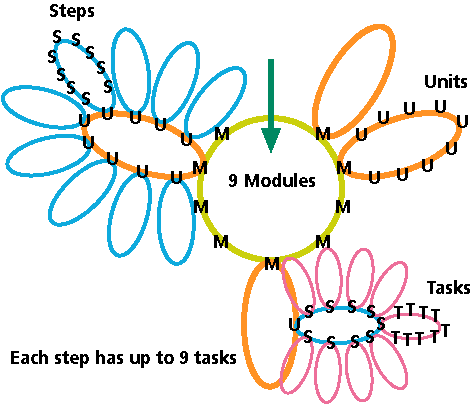
|

|
|
|
| Overview * levels * user's activities - interactions - processes * screen - masks * actions + methods - getting ready - navigating - draw * vars - topLeft - topRight - upLeft - upRight - m+bLeft - m+bRight * project - analysis - tasks - goals - description |
| Levels within software |
| This software is structured on 5 levels (after the startUp): |
| Level | Code | What user can do | ||
| Modules | access to all the modules | switching between modules | ||
| Units | access to units within actual module | switching between units of actual module | ||
| Steps | access to steps within actual unit | switching between steps of actual unit | ||
| Tasks | access to tasks within actual step | switching between tasks of actual step | ||
| Actions | access to actions within actual task | following actions of actual task |
| Top level: access to the modules of this program |

|
The user gets to this level automatically after the startup.
After entering the program a short overview (titles of the modules) is presented and the user has to choose one of the modules.
For more information about a module the user has to switch to that module.
Code
What user can do
|
| 2nd level: access to the units of the actual module |

|
On the top level switching between the modules lets the user preview the contents:
each module presents a short overview (titles of the units of this actual module).
Actually, switching on the top level means entering each module and landing in the first page of this actual module. Staying within a choosen module and selecting one of the units of this actual module means that the user continues on this next deeper level.
The user can preview all the units of this actual module by switching from one unit to another one.
|
|
Code
100fwUnits1. x, 200fwUnits2.x ... = framework of the units within the actual module |
What user can do
|
| 3rd level: access to the steps of the actual unit (within actual module) |

|
Staying within a choosen unit and selecting one of the steps of this actual unit
means that the user continues on this next deeper and 3rd level.
The user can preview all the steps of this actual unit by switching from one step to another one. Each switch on this 3rd level brings the user to the next deeper level and the first page of that step where again a short overview is presented (titles of tasks of actual step). |
|
Code
510fwSteps5.1.x, 520fwSteps5.2.x ... = framework of the steps within the actual unit (of actual module) |
What user can do
|
| 4th level: access to the tasks of the actual step (within actual unit of actual module) |

|
Staying within a choosen step and selecting one of the tasks of this actual step
means that the user continues on this next deeper and 4th level.
The user can preview all the tasks of this actual step by switching from one task to another one.
|
|
Code
561fwTasks5.6.1.x, 562fwTasks5.6.2.x ... = framework of the tasks within the actual step (of actual unit of actual module) |
What user can do
|
| 5th level: access to the actions of the actual task (within actual step of actual unit of actual module) |
|
Within the choosen task there is less choice possible:
the user can go on with action 1, action 2, action 3 and so on or exit the task
and returning to the next higher level for selecting another tasks of this actual step.
The user cannot preview all the actions the same way as previewing on the upper levels. And there is no switching between the actions of a task. The actions have to be worked on in the order given by the program. |
|
Code
56111action5.6.1.1.1, 56112action5.6.1.1.2 ... = actions within the actual task (of actual step of actual unit of actual module) |
What user can do
|
| Overview * levels * user's activities - interactions - processes * screen - masks * actions + methods - getting ready - navigating - draw * vars - topLeft - topRight - upLeft - upRight - m+bLeft - m+bRight * project - analysis - tasks - goals - description |

|
++41 (0)52 301 3301 phone
|
98 06 10 |